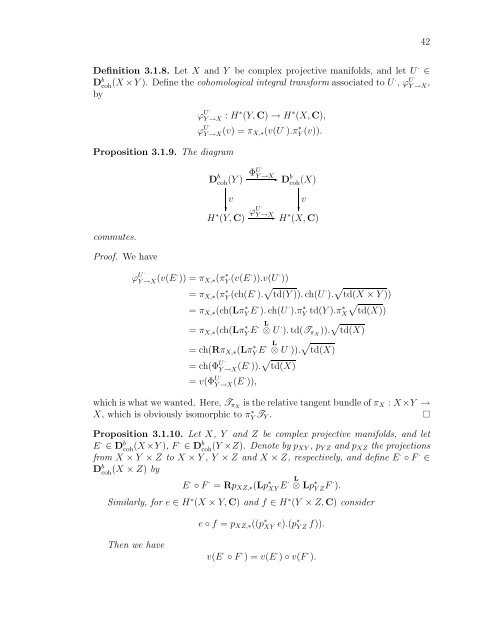derived categories of twisted sheaves on calabi-yau manifolds
derived categories of twisted sheaves on calabi-yau manifolds
derived categories of twisted sheaves on calabi-yau manifolds
Create successful ePaper yourself
Turn your PDF publications into a flip-book with our unique Google optimized e-Paper software.
Definiti<strong>on</strong> 3.1.8. Let X and Y be complex projective <strong>manifolds</strong>, and let U · ∈<br />
Db coh (X × Y ). Define the cohomological integral transform associated to U · U ·<br />
, ϕY →X ,<br />
by<br />
U ·<br />
ϕ<br />
Propositi<strong>on</strong> 3.1.9. The diagram<br />
commutes.<br />
Pro<str<strong>on</strong>g>of</str<strong>on</strong>g>. We have<br />
ϕ<br />
Y →X : H ∗ (Y, C) → H ∗ (X, C),<br />
U ·<br />
Y →X(v) = πX,∗(v(U · ).π ∗ Y (v)).<br />
D b coh(Y )<br />
ΦU ·<br />
Y →X ✲ D b coh(X)<br />
H ∗ v<br />
❄ U ϕ<br />
(Y, C)<br />
·<br />
v<br />
❄<br />
Y →X ✲ ∗<br />
H (X, C)<br />
U ·<br />
ϕY →X(v(E · )) = πX,∗(π ∗ Y (v(E · )).v(U · ))<br />
= πX,∗(π ∗ Y (ch(E · ). td(Y )). ch(U · ). td(X × Y ))<br />
<br />
td(X))<br />
= πX,∗(ch(Lπ ∗ Y E · ). ch(U · ).π ∗ Y td(Y ).π ∗ X<br />
= πX,∗(ch(Lπ ∗ L<br />
·<br />
Y E ⊗ U · ). td(TπX )).td(X) = ch(RπX,∗(Lπ ∗ L<br />
·<br />
Y E ⊗ U · )). td(X)<br />
U ·<br />
= ch(ΦY →X(E · )). td(X)<br />
U ·<br />
= v(ΦY →X(E · )),<br />
which is what we wanted. Here, TπX is the relative tangent bundle <str<strong>on</strong>g>of</str<strong>on</strong>g> πX : X×Y →<br />
X, which is obviously isomorphic to π ∗ Y TY .<br />
Propositi<strong>on</strong> 3.1.10. Let X, Y and Z be complex projective <strong>manifolds</strong>, and let<br />
E · ∈ Db coh (X ×Y ), F · ∈ Db coh (Y ×Z). Denote by pXY , pY Z and pXZ the projecti<strong>on</strong>s<br />
from X × Y × Z to X × Y , Y × Z and X × Z, respectively, and define E · ◦ F · ∈<br />
D b coh<br />
(X × Z) by<br />
E · ◦ F · = RpXZ,∗(Lp ∗ L<br />
·<br />
XY E ⊗ Lp ∗ Y ZF · ).<br />
Similarly, for e ∈ H ∗ (X × Y, C) and f ∈ H ∗ (Y × Z, C) c<strong>on</strong>sider<br />
Then we have<br />
e ◦ f = pXZ,∗((p ∗ XY e).(p ∗ Y Z f)).<br />
v(E · ◦ F · ) = v(E · ) ◦ v(F · ).<br />
42
















